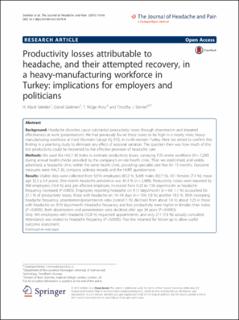| dc.contributor.author | Selekler, HM | |
| dc.contributor.author | Gökmen, G | |
| dc.contributor.author | Alvur, TM | |
| dc.contributor.author | Steiner, Timothy J. | |
| dc.date.accessioned | 2020-03-19T08:27:59Z | |
| dc.date.available | 2020-03-19T08:27:59Z | |
| dc.date.created | 2016-01-24T17:43:33Z | |
| dc.date.issued | 2015 | |
| dc.identifier.citation | The Journal of Headache and Pain. 2015, 16 (1), 1-8. | nb_NO |
| dc.identifier.issn | 1129-2369 | |
| dc.identifier.uri | http://hdl.handle.net/11250/2647482 | |
| dc.description.abstract | Background
Headache disorders cause substantial productivity losses through absenteeism and impaired effectiveness at work (presenteeism). We had previously found these losses to be high in a mostly male, heavy-manufacturing workforce at Ford Otomotiv Sanayi AŞ (FO), in north-western Turkey. Here we aimed to confirm this finding in a year-long study to eliminate any effect of seasonal variation. The question then was how much of this lost productivity could be recovered by the effective provision of headache care.
Methods
We used the HALT-30 Index to estimate productivity losses, surveying FO’s entire workforce (N = 7,200) during annual health-checks provided by the company’s on-site health clinic. Then we established, and widely advertised, a headache clinic within the same health clinic, providing specialist care free for 15 months. Outcome measures were HALT-30, company sickness records and the HURT questionnaire.
Results
Usable data were collected from 5,916 employees (82.2 %; 5,485 males [92.7 %], 431 females [7.3 %]; mean age 32.5 ± 5.4 years). One-month headache prevalence was 45.4 % (n = 2,688). Productivity losses were reported by 968 employees (16.4 %) and, per affected employee, increased from 0.23 to 7.56 days/month as headache frequency increased (P <0005). Employees reporting headache on ≥15 days/month (n = 64; 1.1 %) accounted for 21.1 % of productivity losses, those with headache on 10–14 days (n = 104; 1.8 %) another 18.5 %. With increasing headache frequency, absenteeism/presenteeism ratio (overall 1:16) declined from about 1:4 to about 1:25 in those with headache on ≥10 days/month. Headache frequency and lost productivity were higher in females than males (P <0.0005). Both absenteeism and presenteeism rates declined after age 34 years (P <0.0005).
Only 344 employees with headache (12.8 %) requested appointments, and only 211 (7.8 %) actually consulted. Attendance was related to headache frequency (P <0.0005). Too few returned for follow-up to allow useful outcome assessment.
Conclusion
The high productivity losses in this young mostly male workforce correlated with but were not wholly explained by headache frequency. A small minority of employees with high-frequency headache contributed highly disproportionately to the productivity losses. These should be the target of interventions aimed at productivity recovery. It is not clear what form such interventions should take: making headache care optimally available is not of itself sufficient. | nb_NO |
| dc.language.iso | eng | nb_NO |
| dc.publisher | BMC | nb_NO |
| dc.rights | Navngivelse 4.0 Internasjonal | * |
| dc.rights.uri | http://creativecommons.org/licenses/by/4.0/deed.no | * |
| dc.title | Productivity losses attributable to headache, and their attempted recovery, in a heavy-manufacturing workforce in Turkey: implications for employers and politicians | nb_NO |
| dc.type | Journal article | nb_NO |
| dc.type | Peer reviewed | nb_NO |
| dc.description.version | publishedVersion | nb_NO |
| dc.source.pagenumber | 1-8 | nb_NO |
| dc.source.volume | 16 | nb_NO |
| dc.source.journal | The Journal of Headache and Pain | nb_NO |
| dc.source.issue | 1 | nb_NO |
| dc.identifier.doi | 10.1186/s10194-015-0579-4 | |
| dc.identifier.cristin | 1321083 | |
| dc.description.localcode | © 2015 Selekler et al. Open Access This article is distributed under the terms of the Creative Commons Attribution 4.0 International License (http://creativecommons.org/licenses/by/4.0/), which permits unrestricted use, distribution, and reproduction in any medium, provided you give appropriate credit to the original author(s) and the source, provide a link to the Creative Commons license, and indicate if changes were made. | nb_NO |
| cristin.unitcode | 194,65,30,0 | |
| cristin.unitname | Institutt for nevromedisin og bevegelsesvitenskap | |
| cristin.ispublished | true | |
| cristin.fulltext | original | |
| cristin.qualitycode | 1 | |

